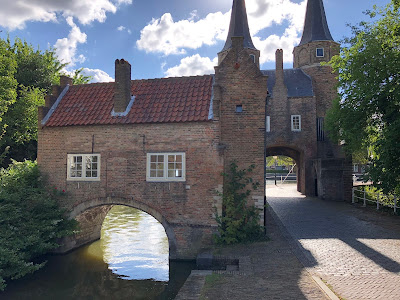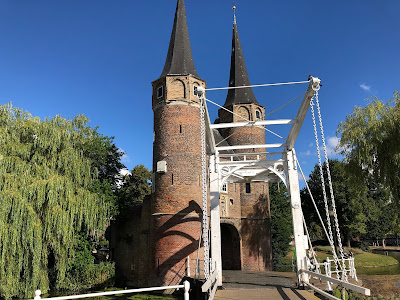




Upper Left: A windmill in Maasland, the Netherlands.
Upper Right: A bike trail in Maasland, the Netherlands.
Lower Left: View from a flour mill in Brielle, the Netherlands, molen 't Vliegend Hert Brielle.
Lower Center: A bike in 's-Hertogenbosch overlooking a canal.
Lower Right: View of Markt (main square) in Delft with rainbow.
Overview
This blog post is about a six-day bike ride we did in Netherlands
covering 200 km (124 miles). We rented
bikes and carried our “luggage” with us. Now before you tsk tsk us for the low number of miles we clocked assuming you remembered
that Holland is pretty flat – hear us out as we try to convince you to that
this was actually too many miles a day.
Before we get to the details of the ride, let’s talk about names for a moment, namely the difference
between the names Netherlands and Holland. The Netherlands is the official name
of the country. Holland is a region (and former province) on the western coast
of the Netherlands that is sometimes used as nonofficial synonym for the
Netherlands by both the Dutch* and non-Dutch. The three largest cities in the
Netherlands are in Holland: Amsterdam, Rotterdam and The Hague.
* The official demonym of people living in the Netherlands is in English the word “Dutch”, which derives from the German deutsch ("German"). “Dutch” referred originally to both Germany and the Netherlands but came to be restricted to the people and language of the Netherlands when that country became independent in the seventeenth century.” [ref]
In this ride, we visited a few of cities in region NL3 (West Netherlands or Holland) and region NL4 (South Netherlands, also called North Brabant). Why did we choose these areas? For a couple of reasons. First, we were flying in and out of Eindhoven and these regions were nearby. And second, we were planning a rendezvous with friends – also traveling on bikes – that were coming from Brussels and these two regions made the most sense for meeting up. However, in retrospect after having experienced the efficiency and frequency of trains, I’d say we could have met our friends and started anywhere we wanted.
(top)
Renting Bikes
One of the first questions you might ask is if you should do a bike
package tour or a do-it-yourself tour? The benefit of a package tour, for
example, those offered by dutch-biketours.com, is that you
don’t have to worry about bike rentals, hotels, and planning, which can be stressful
to set up on your own. The benefit of doing your own tour is that you can
customize your time how you want. We decided to do it ourselves.
So, if you are planning your tour yourself, how and where to
rent a bike is your first challenge to figure out, unless you are coming with your own bike. It seemed to us that bigger cities
(Amsterdam) have a lot of rental options while smaller towns have less. Also, returning
the bike to the rental location is a factor that should be considered. (There were
few services that we saw that allow you to pick up in one location and drop off
in another.) However, it turns out that returning bikes back to a rental location isn’t
that much of a constraint given the efficiency of the trains, which are frequent and efficient.. You can plan a loop route to return to the starting
location. Or, you can take a route that isn’t a loop and use trains to fill in the gaps.
In our case, we ended up renting bikes in the sleepy town of
Roosendaal. We did this because we felt it would be a good point for our rendezvous
with friends. But, the plan of meeting with them fell apart and we ended up taking a
train from Roosendaal to Spijkenisse to meet them and start riding.
Our costs for two hybrid bike rentals (with panniers) was about
150 euros for seven days, a pretty reasonable deal. We spent as much in train
tickets over the six days.
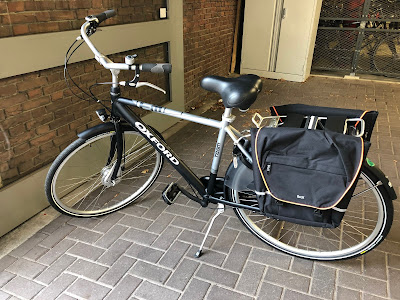





Upper Left: Rented bike with tow 20 L panniers on the back.
Upper Center: Rented bikes in Roosendaal in front of Hotel Tongerlo.
Upper Right: Bikes on a metro train from Rotterdam to Spijkenisse.
Lower Left: Bikes on a national train. These should have the panniers removed! If not, you could be fined.
Lower Center: A ferry crossing the Nieuwe Mass, the Maassluis - Rozenburg connection.
Lower Right: A ferry crossing the Beneden Merwede, the Merwekade - Veerdam connection.
Itinerary
Our itinerary represents just one of an infinite number of possible bike tours. Given that this was our first time doing this, and being hastily planned at that, it didn’t turn out so bad. Our go-to source for information for planning was by far the comprehensive web site hollandcyclingroutes.com (see, even they use the word Holland). We encourage you to watch the introduction videos, which give a nice overview of the bike trails in Netherlands. As well, play around with their Cycle Route Planner to understand distances and routes. You can use Google Maps to plan out “biking” trips, but the Holland Cycling Routes is more comprehensive in terms of its knowledge of trail types.
Our six days in Holland had one part of a day on the front end
where we arrived late in the evening (designated as Day 0) and one travel day
at the end (designated as Day 7). We
also specifically designed our last tour day, Day 6, to be one with no biking riding
so that we could explore a city. That city turned out to be ‘s-Hertogenbosch
(also called Den Bosch, home of Hieronymus Bosch).

An overview of our Netherlands six day bike trip, including segments we planned in bike but didn't do and five train trips we took to complete the tour.
Day 0: Wednesday,
August 8
- Arrive late evening into Eindhoven on a RyanAir flight.
- Take a train to Roosendaal.
- Lodging: Hotel Tongerlo.
Day 1: Thursday,
August 9
- Rent bikes at Roosendaal train station (Rijwielshop Roosendaal).
- Train to Spijkenisse to meet our friends.
- Bike to Rockanje. Distance 30 km (19 mi).
- Lodging: Badhotel – “bad” in Dutch is “bath” in English as in you can swim there or nearby at the beach.
- Dinner: Badhotel
The original plan was to meet our friends in Middelburg and bike from there to Rockanje, but weather and our friends’ previous long days
of riding dictated we change our plan. So, we trained to Spijkenisse to meet them and
took a shorter ride for our first day. It did rain and we got soaked.
Day 2: Friday, August
10
- Bike from Rockanje to Delft. Distance 45 km (28 mi).
- Stop in Brielle to tour molen 't Vliegend Hert Brielle, www.vliegenhert.org, a mill that makes flour you can buy. It was impressive to be able to climb inside the mill and see it working.
- Stop in Maassluis for lunch at Monsieur Paul.
- Lodging: Hotel de Emauspoort.
- Dinner: Mekhong Thai-Lao Restaurant.
Day 3: Saturday, August
11
- Bike from Delft to Gouda by way of The Hague. Distance 50 km (31 mi).
- Before leaving Delft, visit the Vermeer Centrum Delft to get an overview of the life and times of Johannes Vermeer.
- Visit the Mauritshuis museum. Besides being the home of the original Girl with a Pearl Earring by Vermeer, there is lots of other interesting art and it's a cool building.
- Lunch nearby the museum at Barlow.
- Lodging: Best Western City Plus in Gouda.
- Dinner at Koeien en Kaas - Steaks & Cheese.
The Vermeer Centrum in Delft is all about the life and times
of Vermeer using video, interactive exhibits and high-quality reproductions. Later
this day we would see real Vermeer works in the Maurithuis museum in the Hague.
The Hague (Den Haag) is the third largest city in the Netherlands, after
Amsterdam and Rotterdam. The name is probably most familiar to most as the home
of the International Criminal Court.



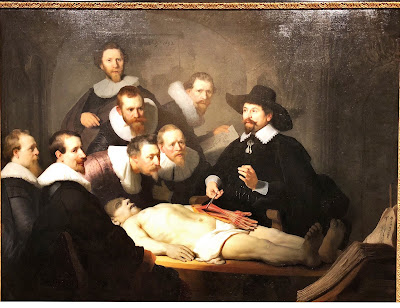
Top Row: Views of Delft. From left to right, Vermeer Centrum, canal leading to east gate, east gate (VE Oostpoort te Delft) internal view, east gate external view, and markt square. Bottom Row: From left to right, Gouda, Maassluis, The Hague and Hofvijver (pond), Rembrandt's The Anatomy Lesson of Dr Nicholaes Tulp (1632) in the Mauritshuis museum.
Day 4: Sunday, August
12
- Bike from Gouda to Dordrecht. Distance 42 km (26 mi).
- Stop at Kinderdijk UNESCO site.
- Lunch at 't Raedhuijs in Alblasserdam.
- Lodging: Villa Augustus.
- Dinner: Villa Augustus.
The Kinderdijk (Child’s Dike) is a UNESCO World Heritage site.
The windmills have pumped water from the low-lying farmlands to the Rhine river
since the Middle Ages. And they are still working today. The bike paths take
you through Kinderdijk without needing to pay, although dodging tourists on the
trail is tricky. You pay if you want access to the museum and some of the
windmills.

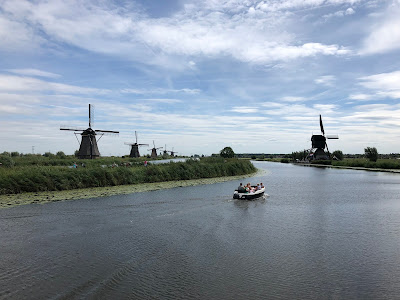


Views of Kinderdijk, The Netherlands. Biking trails run through the park and you are free to enter.
Villa Augustus Hotel & Restaurant was a wonderful find a
little west from city center. It’s the kind of magical and whimsical place that you never
want to leave. It’s there we ran into bleekpotten
literally translated as “bleaching jars” or rhubarb forcers. These traditionally
terracotta pots are cover plants to limit photosynthesis and produced blanched
stems.




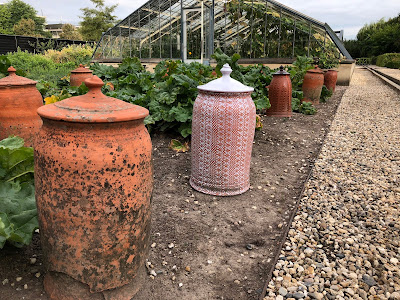

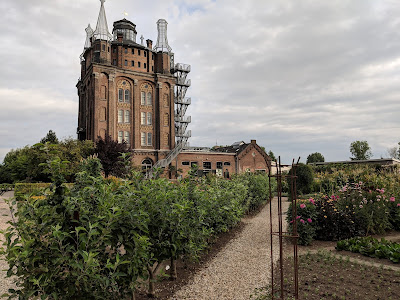
Views of Villa Augusts, Dordrecht, The Netherlands. Top Row: View of Villa Augustus, gardens, and bleekpotten or rhubarb forcers. Bottom Row: Formal garden of Villa Augustus and view of former water tower turned hotel.
Day 5: Monday, August
13
- Train from Dordrecht to Breda.
- Part ways with our friends as they depart to catch a train to Brussels and we continue to Tilburg.
- Bike from Tilburg to 's-Hertogenbosch. Distance 30 km (19 mi).
- Brief stop at Nationaal Park De Loonse en Drunense Duinen.
- Lodging: Hotel Julien.
- Dinner at Restaurant ff Swanjéé.
Restaurant ff Swanjéé in ‘s-Hertogenbosch was one of the
rare restaurants experiences that for us works on many levels, inventiveness of dishes,
service, and ambiance. We don’t often rave that much about food (oh, right!?), but this place
is an exception.
Day 6: Tuesday, August
14
- Spend the day in ‘s-Hertogenbosch (Den Bosch) on foot.
- Day’s activities:
- Binnendieze Tour – tour by boat of Den Bosch.
- Visit Sint-Janskathedraal (St. John’s Cathedral) – a large Gothic church.
- Visit Jheronimus Bosch Art Center – to learn all about world of Hieronymus Bosch.
- Coffee at Drab Coffee | Beans & Machines.
- Lunch at Viswinkel Visch.
- Dinner at Eetbar DIT.
Hieronymus Bosch
(c. 1450 – 1516) was born and spent most of his life in Den Bosch. (I felt
slightly dumb that I didn’t immediately make the connection of his surname to the city.) Bosch
is famous for his pessimistic, erotic, and fantastical imagery depicting all
manners of torture in hell, as probably familiar to most in his most famous
work The Garden
of Earthly Delights. The benefit of the Jheronimus Bosch Art
Center is that through these high-quality prints you can get close to the works
and examine the details. The center occupies a former church dedicated to Saint
James, which lends a contemplative if not somewhat appropriate environment for
thinking about hell.
Talking about earthly delights, we be remiss not to mention Den Bosch’s signature desert which is a large ball-shaped profiterole called a bossche bol.



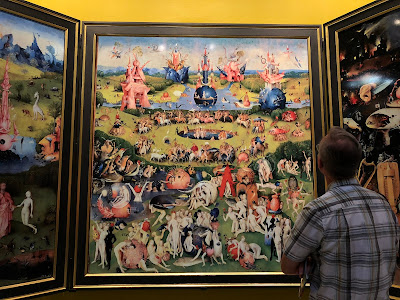
Scenes from the Jheronimus Bosch Art Center in Den Bosch. From left to right: entrance, inside the church-museum space, detail of a reproduction of The Garden of Earthly Delights, and studying the triptych closely.
Day 7: Wednesday, August
15
- Spend the morning in ‘s-Hertogenbosch (Den Bosch).
- Drab Coffee in the morning again.
- Second breakfast at Robbies.
- Visit Het Noordbrabants Museum.
- Lunch at Restaurant ff Swanjéé. We really liked this place and a second visit was fine by us.
- Train to Roosendaal to drop bikes off.
- Train to Eindhoven to catch flight.
We had plenty of time to ride this last day but decided
instead to spend some more time in Den Bosch visiting the Het Noordbrabants Museum,
a museum dedicated to art, culture, and history of the North Brabant, a province
in the south of Netherlands where Den Bosch is located. Van Gogh was born in
this region and the museum features ten of his early, darker works.


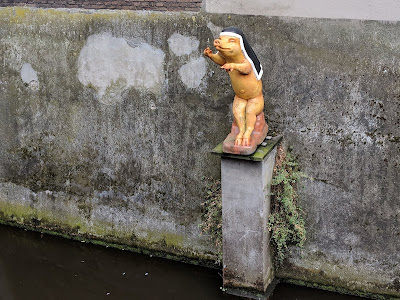







Scenes from around Den Bosch ('s-Hertogenbosch). In the canals, there are whimsical figures taken from Bosch's work. You can see them on foot or take the Binnendieze tour. While on the boat tour you will pass under parts of the city.
Observations
The Soul of the Home
When we visited Amsterdam 15 years ago, I remember being struck by the architecture, particularly of houses. On this visit it was no
different.
- Overall, houses are modest, yet charming and always neat as a pin. The EveryCulture.com site puts it this way about Dutch architecture and use of space: “The Dutch have a desire for spatial organization that is informed by Calvinist assumptions about order as a synonym for cleanliness and sinlessness.” There is a uniformity – or let’s say a harmony – of styles. We concluded that there is probably variation but that we can’t detect it because there are none of the expected architectural outliers we’ve come to know in the USA. Outliers like double-wide trailers with couches and derelict cars in the front yard, or McMansions and their hackneyed two-story porticoes and extra-wide garages.
- House architecture is “open”, specifically, windows invite you from the outside to look inside. Pretty objects are often lined up on windowsills as if to embellish your experience of looking in. There are rarely obscuring curtains, or metals bars, or worse those horrible rolling metal shutters, which unfortunately are de rigueur in Italy. The windows are the key to the soul of a typical Dutch house, and we like that openness. Our friend traveling with us said it was more simply a function of letting in more light. Perhaps, but it probably has more to do with the idea of projecting comfort and coziness, captured in the word gezellig and the closely related Dutch term of hygge.
- Yards, even if fenced, don’t present daunting obstacles. We are sorry to wag a finger again, but have you every experienced a high stone wall in Italy with embedded glass shards and barbed wire as a deterrent? If you have spent any significant amount of time in Italy, you know what we are talking about. We didn’t see anything close to the broken glass – barbed wire combination in the Netherlands. Crime rates may explain the difference between the two countries, but we feel there must be some cultural component to it as well.




The flour mill in Brielle, The Netherlands (molen 't Vliegend Hert Brielle). Note the steep stairs and different types of product produced tarwe zemelen (wheat bran), tarwebloem (wheat flour), tarwegries (wheat groats), volkoren meel (wholegrain flour).
Another aspect that stood out to us in the Netherlands was the
steepness of stairs in houses, and in general. The sensation of steepness
really hit me this trip in the town of Brielle while visiting a windmill. The molen 't Vliegend Hert
Brielle produces flour you can buy in the nearby store. What’s more,
visitors can climb up and go inside the mill to see it working. All this was
impressive and highly recommended, but I kept thinking of my descent on those
steep stairs. (The trick was to treat it like a ladder and face the stairs.) It’s
reported (here
and here)
that steep stairs in house have to do with a history of taxing houses based on
their width, which over time led to narrow and tall houses with stairs designed
to not take up much room.
Food
In general, we ate well, and for a reasonable price. The
Dutch are great at making killer sandwiches. Most mid-level, casual restaurants
feature creative and delicious sandwiches, from ones you can manage to pick up
and eat to ones you need a fork and knife to tackle. The only quibble we have
was that Dutch wait staff we experienced was
okay at best and indifferent and negligent at worse. The exception for us was
at the wonderful Restaurant
ff Swanjéé in ‘s-Hertogenbosch. Besides great food they have a great
wait staff.

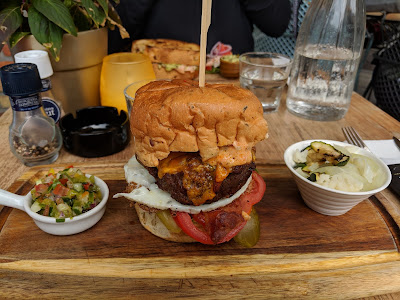








Examples of food we encountered on the trip with emphasis on sandwiches. Top Row: Sandwiches at Restaurant ff Swanjéé in Den Bosch (first two), at Viswinkel Visch in Den Bosch (middle two), and at Monsieur Paul in Maassluis (last two). Bottom Row: Sandwich and soup at 't Raedhuijs in Alblasserdam, a Boscche bol sweet in Den Bosch, a brisket dish at Restaurant ff Swanjéé in Den Bosch, and pickled herring street food in Den Bosch.
Big People, Small
Ponies
The Dutch are tall. By some accounts (BBC Science &
Environment report)
the tallest in the world and by other accounts pretty darn high in the list
(Wikipedia – human
height worldwide). The average Dutch male height is over 6 feet tall,
and he average Dutch female ain’t no slouch either coming in at 5 feet and 7
inches. We felt small compared to Dutch people.
The BBC report delves into some possible reasons including
diet, genetics, and natural selection. The diet angle hinges on Dutch
consumption of ample dairy products, third among countries of the world
according to the World
Atlas. More milk means more
calcium and that leads to more bone growth – or so this line of reasoning goes.
We did my best over our six days to routinely consume as much dairy as we could
but to no avail because we grew wider not taller.
Considering the size of the Dutch, we were puzzled over the number
of miniature ponies we saw in pastures. Apparently, others
have noticed too. The jury is out on the big people and small ponies connection.
Helmet or No Helmet?
Before we left on our trip to Holland The Netherlands, we were researching bike rentals and wondering about renting helmets. In the end, we
did not rent them, and we observed maybe 1 out of 25 bicyclists or fewer with
helmets on the trails. They Cycle Helmets site gives
an estimate of about 0.5% of cyclists in the Netherlands that wear helmets.
Note that in the promotional videos of hollandcyclingroutes.com
riders are not wearing helmets.
In the Netherlands, bicycle helmets are not required, but get
one if you feel comfortable wearing one. Beyond helmet requirements, the holland-cycling
site has a good summary of other the rules to follow while biking.
For as many bicyclists there are in Netherlands (and
Denmark), they have a low helmet use and a low number of fatalities. In
general, the number of cyclists killed per billion km of bicycle travel in the
Netherlands is 25% of that in the USA, while the number bicycle miles traveled
per inhabitant per year is almost 20 times greater in Netherlands than the USA.
[Source: OECD
data.] Like many unresolved questions in this post (tall people,
small ponies, and steep stairs), we can only speculate as to why. The StreetsBlog
USA site comments with “Do more people on bikes cause cycling to
become safer, or does safer infrastructure attract more people to bike? There’s
no conclusive evidence either way, but the answer is probably a mix of both.”
Water and Sky with
Some Earth
The geography of the European* Netherlands Wikipedia
page reports of the total area of the country of 41,543 km2
(16,040 square miles or about two
New Jerseys), the area of water as 7,650 km2 (2,954 square miles –
just over one Delaware) or about
18%. It sure felt like we were pretty much at sea level while we were riding
around. Well, the reason for our perception was that we rode mostly in
the sections of the country that are truly the lowest parts of the West
Netherlands with an average elevation of about 3 m (10 feet) and much of the surface area below sea level.
* Why “European” Netherlands? Because the Netherlands also contains three island territories in the Caribbean (Bonaire, Sint Eustatius and Saba) that together with European Netherlands is the Kingdom of the Netherlands. What!? There is a kingdom – and royals – of Netherlands? Yup, read all about them. They look tall from their photos.
Considering all the Kingdom of the Netherlands, the mean
elevation is 30 m (98 feet). The lowest point is Nieuwerkerk aan den Ijssel at -7
m (-23 feet). (Nieuwerkerk aan den Ijssel is not far from Kinderdijk.) The
highest point is on the island of Saba in the Caribbean that is part of the
Kingdom of Netherlands. In European
Netherlands, the highest point is Vaalserberg at 322.7 m (1,059 feet).



Big skies and sand. Left: Beach at Rockanje. Center and right: The Loonse en Drunense Duinen (Loonse and Drunense Dunes) national park in the south of the Netherlands, between the cities of Tilburg, Waalwijk & 's-Hertogenbosch.
Lessons
Rules of the Road
The holland-cycling.com
site has a good summary of rules to follow while biking. Bells, lights and
reflectors, and signaling turns are compulsory. Helmets are not compulsory.
Talking on the phone or listening to music are allowed but not recommended.
Riding with no hands is not allowed.
Speaking of signaling turns, the correct way to do it
apparently is to extend your right arm straight out for a right turn and your left
arm straight out for a left turn. We goofed this up, just using our left arm to
signal both types of turns. We also made some bonehead moves pulling out into
intersections with oncoming traffic and not waiting for the dedicated bike
traffic light to change.
Another flub: we nearly got a ticket for not removing
panniers from our bikes when riding a train. The conductor let us off the hook
because the train was not crowded or, so she said. The idea is that without the
panniers more bikes can be stacked side by side. We left the panniers on because we were lazy.
It makes sense to remove them, because then you have your belongings with you
and you don’t have to sit close to your bikes to “watch” your belongings in the
panniers. For security on trains, we would engage the back-tire lock for short
trips. For longer trips, we would also chain our bikes together and to a
handhold, less for security and more to keep them from tumbling over.
If you get one thing out of this blog post, it will be to go
to both the holland-cycling.com
and hollandcyclingroutes.com
sites. On the latter, there are some overview videos that give you an idea of
planning routes and using junction routes (local features) and long-distance
routes (LF routes).








Views of the trails we rode on. Top Row: Heading into Brielle; Heading to Gouda; Leaving Brielle and Heading to Delft; Leaving Gouda and heading to Dordrecht. Bottom Row: Maassluis, Riding near the Nationaal Park De Loonse en Drunense Duinen; Riding to Dordrecht.; On the way to Gouda.
Navigation
In our group of four, we designated one person as the
navigator who used the Fietsplanner app
to ride in front. One challenge of this app is that it is only in Dutch,
as of writing this. However, navigation instructions are kind of universal and
so it’s not out of the question to use it if you are comfortable with other
mapping applications. The phone running the Fietsplanner app app was in a bike
phone holder mounted on the center bar for hands-free operation.
A backseat driver in our group used Google Maps to second
guess us most of the way and the agreement between Fietsplanner and Google Maps
wasn’t bad, but Fietsplanner knows more about the prettiest and most
interesting routes to take.
You can also see in the videos on hollandcyclingroutes.com
and, as well we saw in stores, what are node cards (knooppuntkaartjes) for following directions. The idea is you plan
out your trip ahead creating a node card which has a sequence of nodes and each node indicates a trail change. See the attached image.
Some of routes included a ferry passage across a river. We
found in one case, a machine to buy tickets, in all three times we used a ferry
we found you could pay on board, usually 1 – 2 euros per person.
Pack Lightly
With a typical rental (like ours) panniers are either included or an extra small feed per day. We only used panniers attached to the frame over the rear tire of our bikes. Panniers are either water proof as is
or come with a rain cover. (If your panniers are not waterproof, make sure the
rental place gives you covers.) Each of our bikes had two panniers of 20 liters
a piece for 40 L per person. We also brought our own handlebar
bag, which was useful for holding a snack, a bottle of water, and
other easy to grab stuff that could be accessed while riding.
We found that the strategy of using small soft containers (for
example, Eagle
Creek packing cubes) was a good organizational principle. One for
underwear and socks. One for shirts. One for toiletries. One for pullovers and
outer gear. One for electronics (plugs, cables, chargers, etc.). Packing our
unpacking the panniers was then just a matter of pulling out the smaller
containers.
When we left our bikes for a period, say to go into a
restaurant, we had a small shoulder bag we used to hold valuables so that they
were always with us.
Expect Wind and Rain
How profound is that? We thought that it being summer (August) we would see little rain. Well,
we got drenched day one (and then never again) as if to teach us a lesson. We
discovered the hard way that wearing light biking gear that dries easily is key
with rain. (We didn’t have it on the day it rained.) Having panniers that are
water-resistant or have a rain cover is also important, so that you have dry
clothes to change into.
We tried to look at wind forecasts and seasonal wind
patterns to understand what we might be facing in terms of wind, but, in the
end, we didn’t come up with anything useful. Probably the most useful thing you
can do is keep track of the weather systems unfolding around you and plan
accordingly.
Less Miles is More
Our advice: don’t try to rack up the miles each day. Rather,
make sure you stop to enjoy the sights. When we were in the planning phase of
this trip, we thought we could easily hit about 60 – 70 km (37 to 43 miles) a
day and we could have but didn’t. Our actual average mileage per day was more
like 40 km (25 miles) a day.
If you are going for maximum miles, you will end up “seeing” the country
from the seat of the bike with less “experiencing” or “learning” about it on
foo. To be honest, we
would have gladly ridden less miles than we did to free up more time to see sights along
the way and in each city where we stayed. As it was, I felt we missed a lot.
If we had more time, we probably would have alternated ride
days with days in the city on foot. That would have been more like a 10-day
tour, but I think we would have gotten more out of it because we learn more about a city walking around, as well as visiting museums.
(top)




Left: Example of a bike route sign, route 83 to Den Bosch. Center left: Reading a route map in Maassluis. Center right: Notice advising of a closure, gesloten. Right: Node cards (knooppuntkaartjes).
(top)
Glossary
This Dutch to English glossary was developed for two
reasons. First, in what scanty research we did before departing for Holland, we
found that we quickly needed to know a few basic words just to understand the
bike rental web sites.
Second, once on the ground in Holland, we became interested
in understanding the signs we saw and so we started keeping a list of the most
common signs we encountered.
This glossary will not help you speak Dutch but might be of
use in some situations such as understanding if a shop is open or closed, where
the entrance or exit is, negotiating the train station, and maybe deciphering
just a few terms on a menu. Good luck!




Left: Example of a bike route sign, route 83 to Den Bosch. Center left: Reading a route map in Maassluis. Center right: Notice advising of a closure, gesloten. Right: Node cards (knooppuntkaartjes).
Dutch – English (to the best of our ability)
adres – address,
as on a web site to put in your address
akkoord = accept,
as on a web site to accept cookies
bezoek – visit
boek nu – book now
binnenstad – inner
city
dank je – thank
you
dijk – dike or
dyke. A common feature in Holland. Didn’t know this word was so overloaded
in English.
drinken – drink
fiets inruilen – bike
exchange/trade-in
fietsaanhanger – bike
trailer
fietsen – bicycles
fietsenhuis –
cycling house; a shop that deals in bikes, either renting or selling them.
fietsenstalling –
bike storage
fietsers welkom! =
cyclists welcome! Sign to indicate that a hotel or restaurant welcomes bikers.
In other words, don’t feel bad about wearing your bike shorts!
fietshuur – bike
rental
fietspad – bake
path
fietstassen – panniers
for a bike
fietswinkel – bike
shop
forel – trout
(fish)
geen – no
geopend – opened. Geopend and gesloten are what you see in shop windows. So, before pushing extra
hard to open a closed door, check if it is geopend
or gesloten.
gereserveerd –
reserved, as in a space reserved on the train for bikes or a table reserved in a restaurant.
gesloten – closed
groente –
vegetable
haring – herring
(fish)
honde – dog
huur – rent. See verhuur.
hybride fiets –
hybrid bike, the most practical bike for this kind of touring described in the
blog post.
helm – helmet
ingang – entrance
je – you, as in dank je or “thank you”
kerk – church
kinderzitje voor –
child seat
kinderzitje achter
– rear child seat
koffie – coffee
maak verbinding –
connect, as in when you join a WIFI and you need click “connect”
makreel – mackerel
(fish)
markt – market.
Easy, huh?
melk – milk
naar – to, as in “to”
where you are going when working with the Holland
Cyling Route Planner.
nieu/nieuwe – new.
In Delft, for example, there is Nieuwe Kerk (“new church”) and Oude Kerk (“old
church”).
noorden – north
opmerkingen –
comments, as in on a web site.
oost – east
oude – old. See nieu/we.
over ons – about
us, as typically used on a web site.
pad – path as in fietspad
paling – eel
(fish)
pedalen racefiets –
race pedals. Really not needed for the kind of biking described in this blog
post.
roken – smoking
rijwielshop – bike
shop
rookzones –
smoking areas
spoor – track.
Useful for finding what track your train is arriving on or departing from.
stadfiets – city bike.
You probably don’t want this type of bike for the kind of biking described in
this blog post.
stadhius – town
hall. Head to the town hall to find the heart of the city.
tarwe – wheat. Wheat bran would be tarwe zemelen like we saw in the flour mill in Brielle.
te huur – for rent
te huur – for rent
te koop – for sale
tonijn – tuna
(fish)
tots ziens –
goodbye. You typically see this sign when leaving a city.
trein – train
tuin – garden
tweewieler – two-wheeler,
referring to bikes
tweewielercentrum –
bike center
uitgang – exit
uitzondering –
exception. It’s useful to know this word for signs on trails or streets that
restrict some modes of transportation, like cars or motorcycles, but allow
bikes.
van – from, as in
“from” where you are coming when working with the Holland
Cyling Route Planner.
verhuur – rental
verzenden – send, as
in sending request or completing a form on a web site.
vijver – pond. In the center of Hague, there is the famous pond Hofvijver.
voorrang –
priority. Look for this sign on trains to see where bikes can be stored.
welkom – welcome
westen – west
winkel – store. For
example, kookwinkel is a cooking
store.
zalm – salmon
(fish)
zuiden – south


